Promoting Value Diversity: Challenges for Managers in the 21st Century
VerifiedAdded on 2023/06/13
|9
|2606
|452
Essay
AI Summary
This essay examines the increasing significance of workplace diversity, highlighting its benefits such as access to talent pools, improved customer satisfaction, and increased productivity. It discusses the challenges in managing diversity, including the 'glass ceiling' effect that hinders women and minorities. The essay explores theories like socio-cultural and situated learning approaches to understand diversity's impact. It also addresses the challenges new managers face in the 21st century, such as training diverse employees, overcoming prejudice, and ensuring fair treatment, while also recognizing the opportunities diversity presents for innovation and enhanced teamwork. The conclusion emphasizes the importance of promoting diversity to eliminate the glass ceiling effect and foster equality.
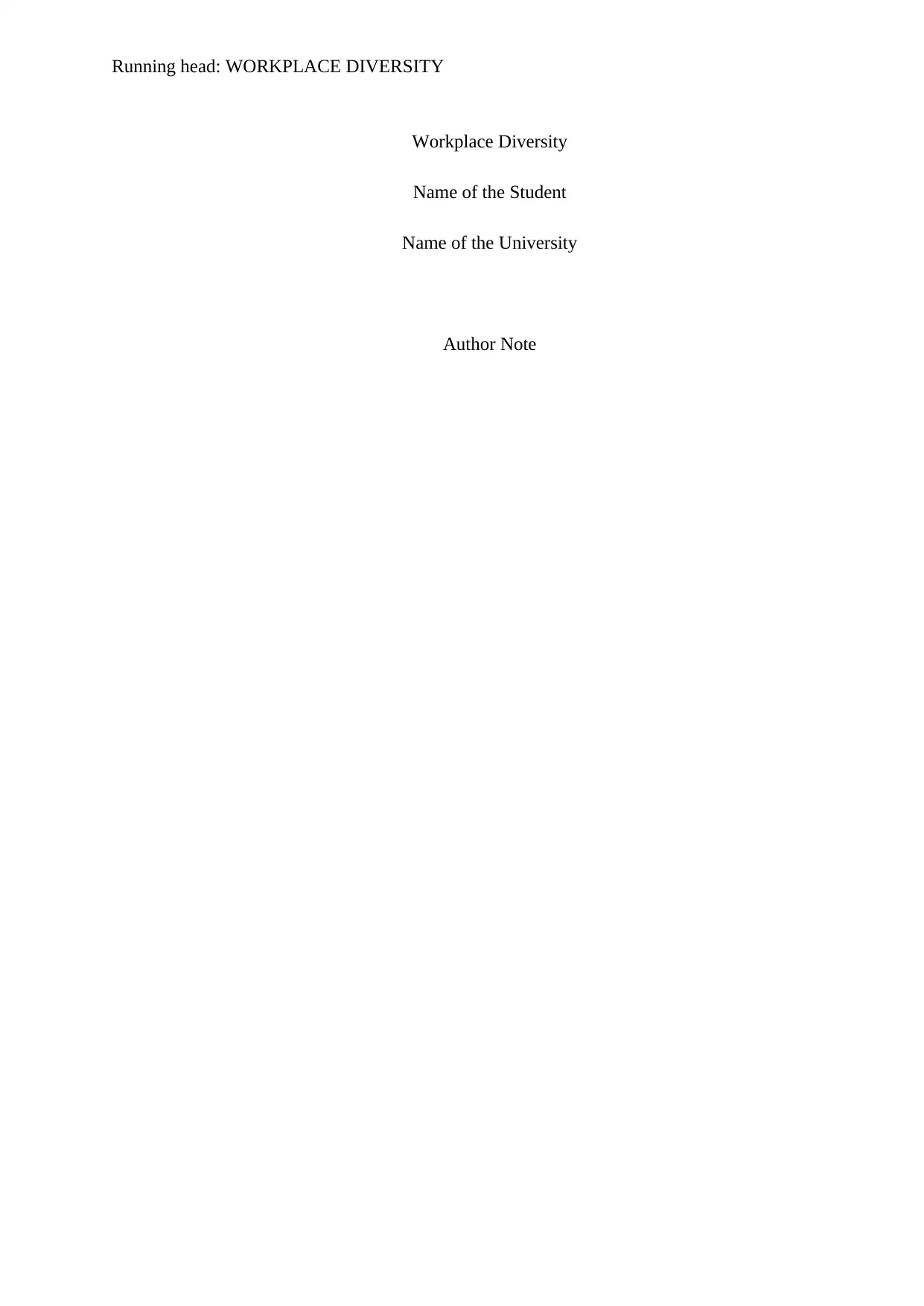
Running head: WORKPLACE DIVERSITY
Workplace Diversity
Name of the Student
Name of the University
Author Note
Workplace Diversity
Name of the Student
Name of the University
Author Note
Paraphrase This Document
Need a fresh take? Get an instant paraphrase of this document with our AI Paraphraser
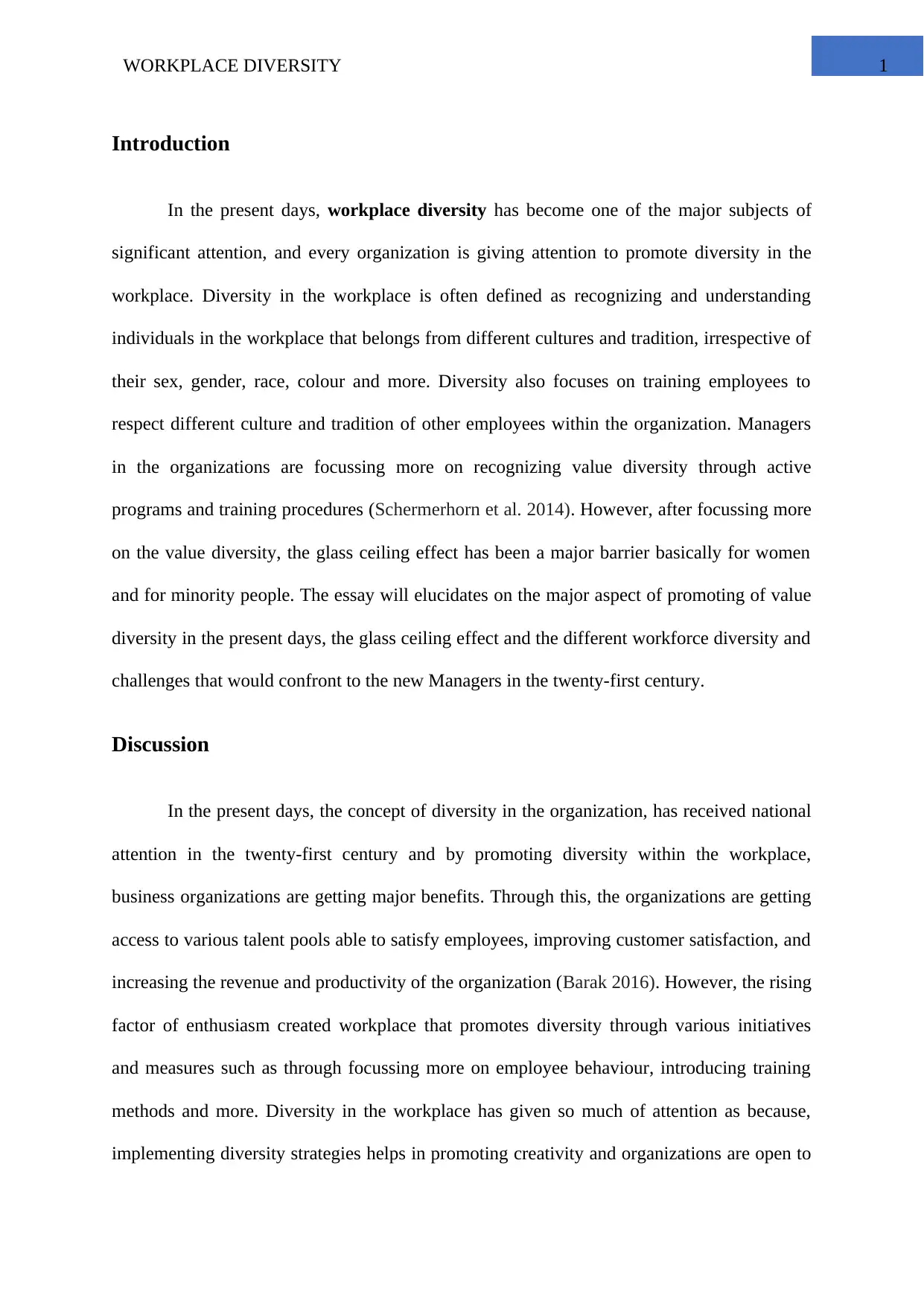
1WORKPLACE DIVERSITY
Introduction
In the present days, workplace diversity has become one of the major subjects of
significant attention, and every organization is giving attention to promote diversity in the
workplace. Diversity in the workplace is often defined as recognizing and understanding
individuals in the workplace that belongs from different cultures and tradition, irrespective of
their sex, gender, race, colour and more. Diversity also focuses on training employees to
respect different culture and tradition of other employees within the organization. Managers
in the organizations are focussing more on recognizing value diversity through active
programs and training procedures (Schermerhorn et al. 2014). However, after focussing more
on the value diversity, the glass ceiling effect has been a major barrier basically for women
and for minority people. The essay will elucidates on the major aspect of promoting of value
diversity in the present days, the glass ceiling effect and the different workforce diversity and
challenges that would confront to the new Managers in the twenty-first century.
Discussion
In the present days, the concept of diversity in the organization, has received national
attention in the twenty-first century and by promoting diversity within the workplace,
business organizations are getting major benefits. Through this, the organizations are getting
access to various talent pools able to satisfy employees, improving customer satisfaction, and
increasing the revenue and productivity of the organization (Barak 2016). However, the rising
factor of enthusiasm created workplace that promotes diversity through various initiatives
and measures such as through focussing more on employee behaviour, introducing training
methods and more. Diversity in the workplace has given so much of attention as because,
implementing diversity strategies helps in promoting creativity and organizations are open to
Introduction
In the present days, workplace diversity has become one of the major subjects of
significant attention, and every organization is giving attention to promote diversity in the
workplace. Diversity in the workplace is often defined as recognizing and understanding
individuals in the workplace that belongs from different cultures and tradition, irrespective of
their sex, gender, race, colour and more. Diversity also focuses on training employees to
respect different culture and tradition of other employees within the organization. Managers
in the organizations are focussing more on recognizing value diversity through active
programs and training procedures (Schermerhorn et al. 2014). However, after focussing more
on the value diversity, the glass ceiling effect has been a major barrier basically for women
and for minority people. The essay will elucidates on the major aspect of promoting of value
diversity in the present days, the glass ceiling effect and the different workforce diversity and
challenges that would confront to the new Managers in the twenty-first century.
Discussion
In the present days, the concept of diversity in the organization, has received national
attention in the twenty-first century and by promoting diversity within the workplace,
business organizations are getting major benefits. Through this, the organizations are getting
access to various talent pools able to satisfy employees, improving customer satisfaction, and
increasing the revenue and productivity of the organization (Barak 2016). However, the rising
factor of enthusiasm created workplace that promotes diversity through various initiatives
and measures such as through focussing more on employee behaviour, introducing training
methods and more. Diversity in the workplace has given so much of attention as because,
implementing diversity strategies helps in promoting creativity and organizations are open to
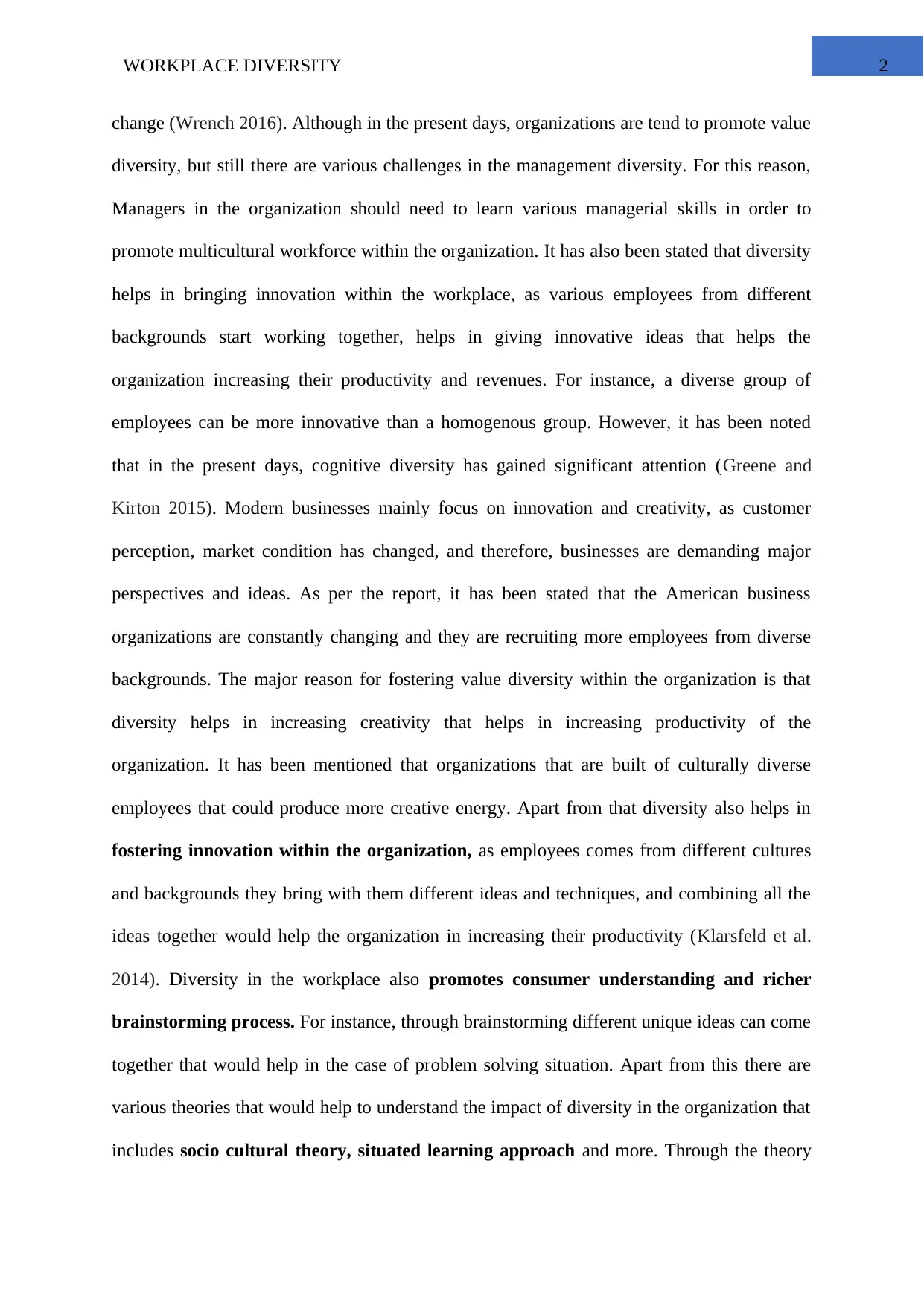
2WORKPLACE DIVERSITY
change (Wrench 2016). Although in the present days, organizations are tend to promote value
diversity, but still there are various challenges in the management diversity. For this reason,
Managers in the organization should need to learn various managerial skills in order to
promote multicultural workforce within the organization. It has also been stated that diversity
helps in bringing innovation within the workplace, as various employees from different
backgrounds start working together, helps in giving innovative ideas that helps the
organization increasing their productivity and revenues. For instance, a diverse group of
employees can be more innovative than a homogenous group. However, it has been noted
that in the present days, cognitive diversity has gained significant attention (Greene and
Kirton 2015). Modern businesses mainly focus on innovation and creativity, as customer
perception, market condition has changed, and therefore, businesses are demanding major
perspectives and ideas. As per the report, it has been stated that the American business
organizations are constantly changing and they are recruiting more employees from diverse
backgrounds. The major reason for fostering value diversity within the organization is that
diversity helps in increasing creativity that helps in increasing productivity of the
organization. It has been mentioned that organizations that are built of culturally diverse
employees that could produce more creative energy. Apart from that diversity also helps in
fostering innovation within the organization, as employees comes from different cultures
and backgrounds they bring with them different ideas and techniques, and combining all the
ideas together would help the organization in increasing their productivity (Klarsfeld et al.
2014). Diversity in the workplace also promotes consumer understanding and richer
brainstorming process. For instance, through brainstorming different unique ideas can come
together that would help in the case of problem solving situation. Apart from this there are
various theories that would help to understand the impact of diversity in the organization that
includes socio cultural theory, situated learning approach and more. Through the theory
change (Wrench 2016). Although in the present days, organizations are tend to promote value
diversity, but still there are various challenges in the management diversity. For this reason,
Managers in the organization should need to learn various managerial skills in order to
promote multicultural workforce within the organization. It has also been stated that diversity
helps in bringing innovation within the workplace, as various employees from different
backgrounds start working together, helps in giving innovative ideas that helps the
organization increasing their productivity and revenues. For instance, a diverse group of
employees can be more innovative than a homogenous group. However, it has been noted
that in the present days, cognitive diversity has gained significant attention (Greene and
Kirton 2015). Modern businesses mainly focus on innovation and creativity, as customer
perception, market condition has changed, and therefore, businesses are demanding major
perspectives and ideas. As per the report, it has been stated that the American business
organizations are constantly changing and they are recruiting more employees from diverse
backgrounds. The major reason for fostering value diversity within the organization is that
diversity helps in increasing creativity that helps in increasing productivity of the
organization. It has been mentioned that organizations that are built of culturally diverse
employees that could produce more creative energy. Apart from that diversity also helps in
fostering innovation within the organization, as employees comes from different cultures
and backgrounds they bring with them different ideas and techniques, and combining all the
ideas together would help the organization in increasing their productivity (Klarsfeld et al.
2014). Diversity in the workplace also promotes consumer understanding and richer
brainstorming process. For instance, through brainstorming different unique ideas can come
together that would help in the case of problem solving situation. Apart from this there are
various theories that would help to understand the impact of diversity in the organization that
includes socio cultural theory, situated learning approach and more. Through the theory
⊘ This is a preview!⊘
Do you want full access?
Subscribe today to unlock all pages.

Trusted by 1+ million students worldwide
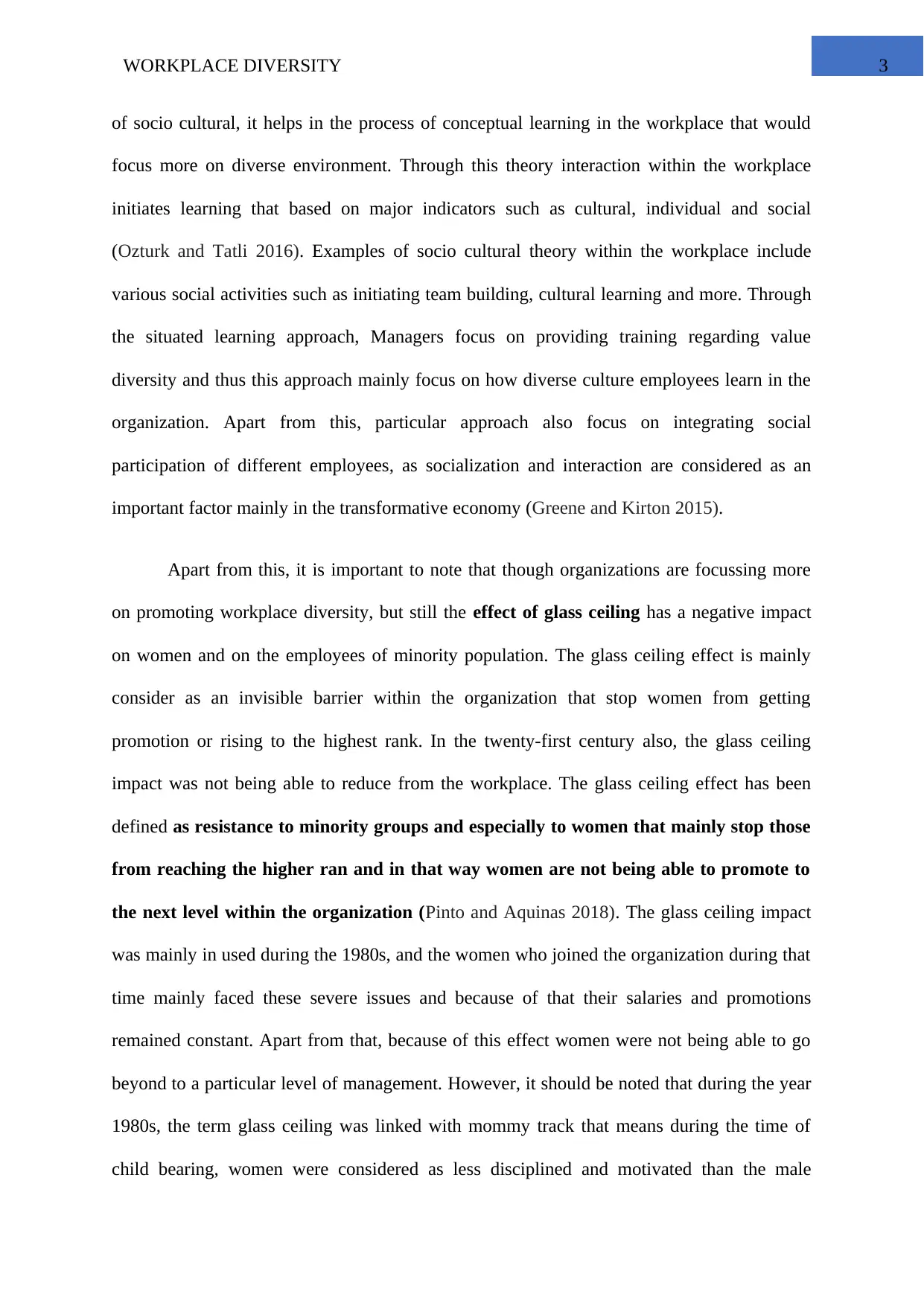
3WORKPLACE DIVERSITY
of socio cultural, it helps in the process of conceptual learning in the workplace that would
focus more on diverse environment. Through this theory interaction within the workplace
initiates learning that based on major indicators such as cultural, individual and social
(Ozturk and Tatli 2016). Examples of socio cultural theory within the workplace include
various social activities such as initiating team building, cultural learning and more. Through
the situated learning approach, Managers focus on providing training regarding value
diversity and thus this approach mainly focus on how diverse culture employees learn in the
organization. Apart from this, particular approach also focus on integrating social
participation of different employees, as socialization and interaction are considered as an
important factor mainly in the transformative economy (Greene and Kirton 2015).
Apart from this, it is important to note that though organizations are focussing more
on promoting workplace diversity, but still the effect of glass ceiling has a negative impact
on women and on the employees of minority population. The glass ceiling effect is mainly
consider as an invisible barrier within the organization that stop women from getting
promotion or rising to the highest rank. In the twenty-first century also, the glass ceiling
impact was not being able to reduce from the workplace. The glass ceiling effect has been
defined as resistance to minority groups and especially to women that mainly stop those
from reaching the higher ran and in that way women are not being able to promote to
the next level within the organization (Pinto and Aquinas 2018). The glass ceiling impact
was mainly in used during the 1980s, and the women who joined the organization during that
time mainly faced these severe issues and because of that their salaries and promotions
remained constant. Apart from that, because of this effect women were not being able to go
beyond to a particular level of management. However, it should be noted that during the year
1980s, the term glass ceiling was linked with mommy track that means during the time of
child bearing, women were considered as less disciplined and motivated than the male
of socio cultural, it helps in the process of conceptual learning in the workplace that would
focus more on diverse environment. Through this theory interaction within the workplace
initiates learning that based on major indicators such as cultural, individual and social
(Ozturk and Tatli 2016). Examples of socio cultural theory within the workplace include
various social activities such as initiating team building, cultural learning and more. Through
the situated learning approach, Managers focus on providing training regarding value
diversity and thus this approach mainly focus on how diverse culture employees learn in the
organization. Apart from this, particular approach also focus on integrating social
participation of different employees, as socialization and interaction are considered as an
important factor mainly in the transformative economy (Greene and Kirton 2015).
Apart from this, it is important to note that though organizations are focussing more
on promoting workplace diversity, but still the effect of glass ceiling has a negative impact
on women and on the employees of minority population. The glass ceiling effect is mainly
consider as an invisible barrier within the organization that stop women from getting
promotion or rising to the highest rank. In the twenty-first century also, the glass ceiling
impact was not being able to reduce from the workplace. The glass ceiling effect has been
defined as resistance to minority groups and especially to women that mainly stop those
from reaching the higher ran and in that way women are not being able to promote to
the next level within the organization (Pinto and Aquinas 2018). The glass ceiling impact
was mainly in used during the 1980s, and the women who joined the organization during that
time mainly faced these severe issues and because of that their salaries and promotions
remained constant. Apart from that, because of this effect women were not being able to go
beyond to a particular level of management. However, it should be noted that during the year
1980s, the term glass ceiling was linked with mommy track that means during the time of
child bearing, women were considered as less disciplined and motivated than the male
Paraphrase This Document
Need a fresh take? Get an instant paraphrase of this document with our AI Paraphraser
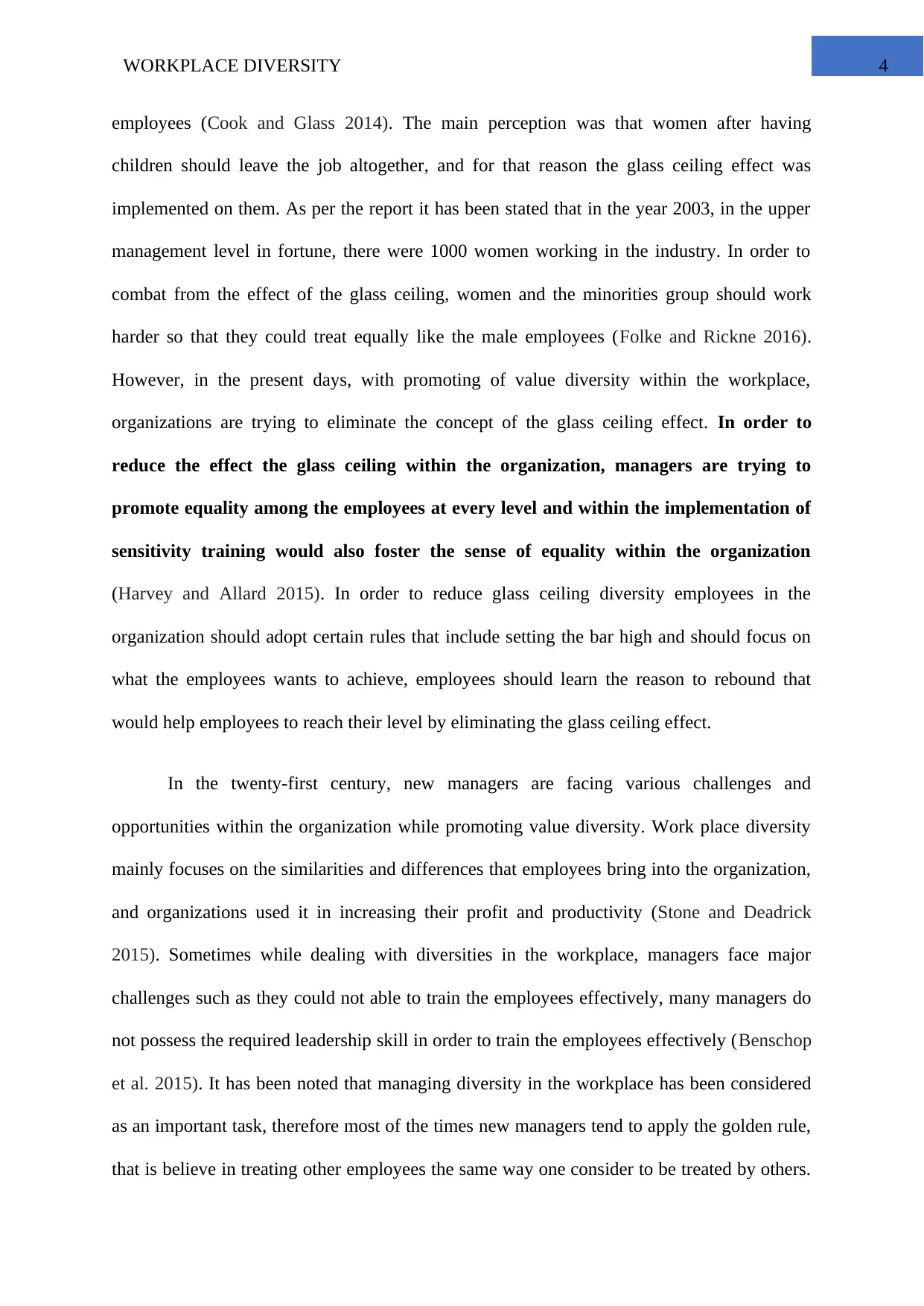
4WORKPLACE DIVERSITY
employees (Cook and Glass 2014). The main perception was that women after having
children should leave the job altogether, and for that reason the glass ceiling effect was
implemented on them. As per the report it has been stated that in the year 2003, in the upper
management level in fortune, there were 1000 women working in the industry. In order to
combat from the effect of the glass ceiling, women and the minorities group should work
harder so that they could treat equally like the male employees (Folke and Rickne 2016).
However, in the present days, with promoting of value diversity within the workplace,
organizations are trying to eliminate the concept of the glass ceiling effect. In order to
reduce the effect the glass ceiling within the organization, managers are trying to
promote equality among the employees at every level and within the implementation of
sensitivity training would also foster the sense of equality within the organization
(Harvey and Allard 2015). In order to reduce glass ceiling diversity employees in the
organization should adopt certain rules that include setting the bar high and should focus on
what the employees wants to achieve, employees should learn the reason to rebound that
would help employees to reach their level by eliminating the glass ceiling effect.
In the twenty-first century, new managers are facing various challenges and
opportunities within the organization while promoting value diversity. Work place diversity
mainly focuses on the similarities and differences that employees bring into the organization,
and organizations used it in increasing their profit and productivity (Stone and Deadrick
2015). Sometimes while dealing with diversities in the workplace, managers face major
challenges such as they could not able to train the employees effectively, many managers do
not possess the required leadership skill in order to train the employees effectively (Benschop
et al. 2015). It has been noted that managing diversity in the workplace has been considered
as an important task, therefore most of the times new managers tend to apply the golden rule,
that is believe in treating other employees the same way one consider to be treated by others.
employees (Cook and Glass 2014). The main perception was that women after having
children should leave the job altogether, and for that reason the glass ceiling effect was
implemented on them. As per the report it has been stated that in the year 2003, in the upper
management level in fortune, there were 1000 women working in the industry. In order to
combat from the effect of the glass ceiling, women and the minorities group should work
harder so that they could treat equally like the male employees (Folke and Rickne 2016).
However, in the present days, with promoting of value diversity within the workplace,
organizations are trying to eliminate the concept of the glass ceiling effect. In order to
reduce the effect the glass ceiling within the organization, managers are trying to
promote equality among the employees at every level and within the implementation of
sensitivity training would also foster the sense of equality within the organization
(Harvey and Allard 2015). In order to reduce glass ceiling diversity employees in the
organization should adopt certain rules that include setting the bar high and should focus on
what the employees wants to achieve, employees should learn the reason to rebound that
would help employees to reach their level by eliminating the glass ceiling effect.
In the twenty-first century, new managers are facing various challenges and
opportunities within the organization while promoting value diversity. Work place diversity
mainly focuses on the similarities and differences that employees bring into the organization,
and organizations used it in increasing their profit and productivity (Stone and Deadrick
2015). Sometimes while dealing with diversities in the workplace, managers face major
challenges such as they could not able to train the employees effectively, many managers do
not possess the required leadership skill in order to train the employees effectively (Benschop
et al. 2015). It has been noted that managing diversity in the workplace has been considered
as an important task, therefore most of the times new managers tend to apply the golden rule,
that is believe in treating other employees the same way one consider to be treated by others.
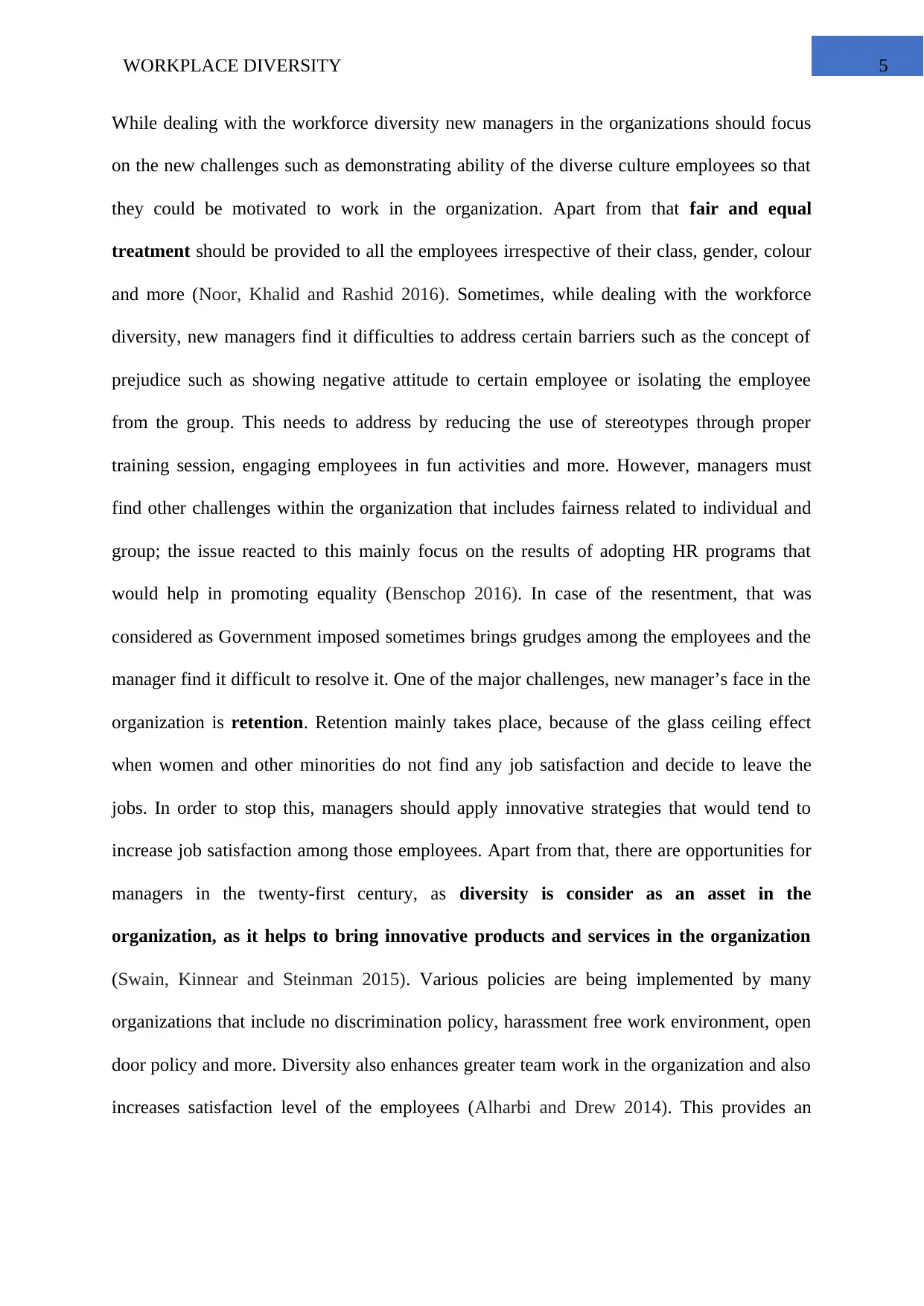
5WORKPLACE DIVERSITY
While dealing with the workforce diversity new managers in the organizations should focus
on the new challenges such as demonstrating ability of the diverse culture employees so that
they could be motivated to work in the organization. Apart from that fair and equal
treatment should be provided to all the employees irrespective of their class, gender, colour
and more (Noor, Khalid and Rashid 2016). Sometimes, while dealing with the workforce
diversity, new managers find it difficulties to address certain barriers such as the concept of
prejudice such as showing negative attitude to certain employee or isolating the employee
from the group. This needs to address by reducing the use of stereotypes through proper
training session, engaging employees in fun activities and more. However, managers must
find other challenges within the organization that includes fairness related to individual and
group; the issue reacted to this mainly focus on the results of adopting HR programs that
would help in promoting equality (Benschop 2016). In case of the resentment, that was
considered as Government imposed sometimes brings grudges among the employees and the
manager find it difficult to resolve it. One of the major challenges, new manager’s face in the
organization is retention. Retention mainly takes place, because of the glass ceiling effect
when women and other minorities do not find any job satisfaction and decide to leave the
jobs. In order to stop this, managers should apply innovative strategies that would tend to
increase job satisfaction among those employees. Apart from that, there are opportunities for
managers in the twenty-first century, as diversity is consider as an asset in the
organization, as it helps to bring innovative products and services in the organization
(Swain, Kinnear and Steinman 2015). Various policies are being implemented by many
organizations that include no discrimination policy, harassment free work environment, open
door policy and more. Diversity also enhances greater team work in the organization and also
increases satisfaction level of the employees (Alharbi and Drew 2014). This provides an
While dealing with the workforce diversity new managers in the organizations should focus
on the new challenges such as demonstrating ability of the diverse culture employees so that
they could be motivated to work in the organization. Apart from that fair and equal
treatment should be provided to all the employees irrespective of their class, gender, colour
and more (Noor, Khalid and Rashid 2016). Sometimes, while dealing with the workforce
diversity, new managers find it difficulties to address certain barriers such as the concept of
prejudice such as showing negative attitude to certain employee or isolating the employee
from the group. This needs to address by reducing the use of stereotypes through proper
training session, engaging employees in fun activities and more. However, managers must
find other challenges within the organization that includes fairness related to individual and
group; the issue reacted to this mainly focus on the results of adopting HR programs that
would help in promoting equality (Benschop 2016). In case of the resentment, that was
considered as Government imposed sometimes brings grudges among the employees and the
manager find it difficult to resolve it. One of the major challenges, new manager’s face in the
organization is retention. Retention mainly takes place, because of the glass ceiling effect
when women and other minorities do not find any job satisfaction and decide to leave the
jobs. In order to stop this, managers should apply innovative strategies that would tend to
increase job satisfaction among those employees. Apart from that, there are opportunities for
managers in the twenty-first century, as diversity is consider as an asset in the
organization, as it helps to bring innovative products and services in the organization
(Swain, Kinnear and Steinman 2015). Various policies are being implemented by many
organizations that include no discrimination policy, harassment free work environment, open
door policy and more. Diversity also enhances greater team work in the organization and also
increases satisfaction level of the employees (Alharbi and Drew 2014). This provides an
⊘ This is a preview!⊘
Do you want full access?
Subscribe today to unlock all pages.

Trusted by 1+ million students worldwide
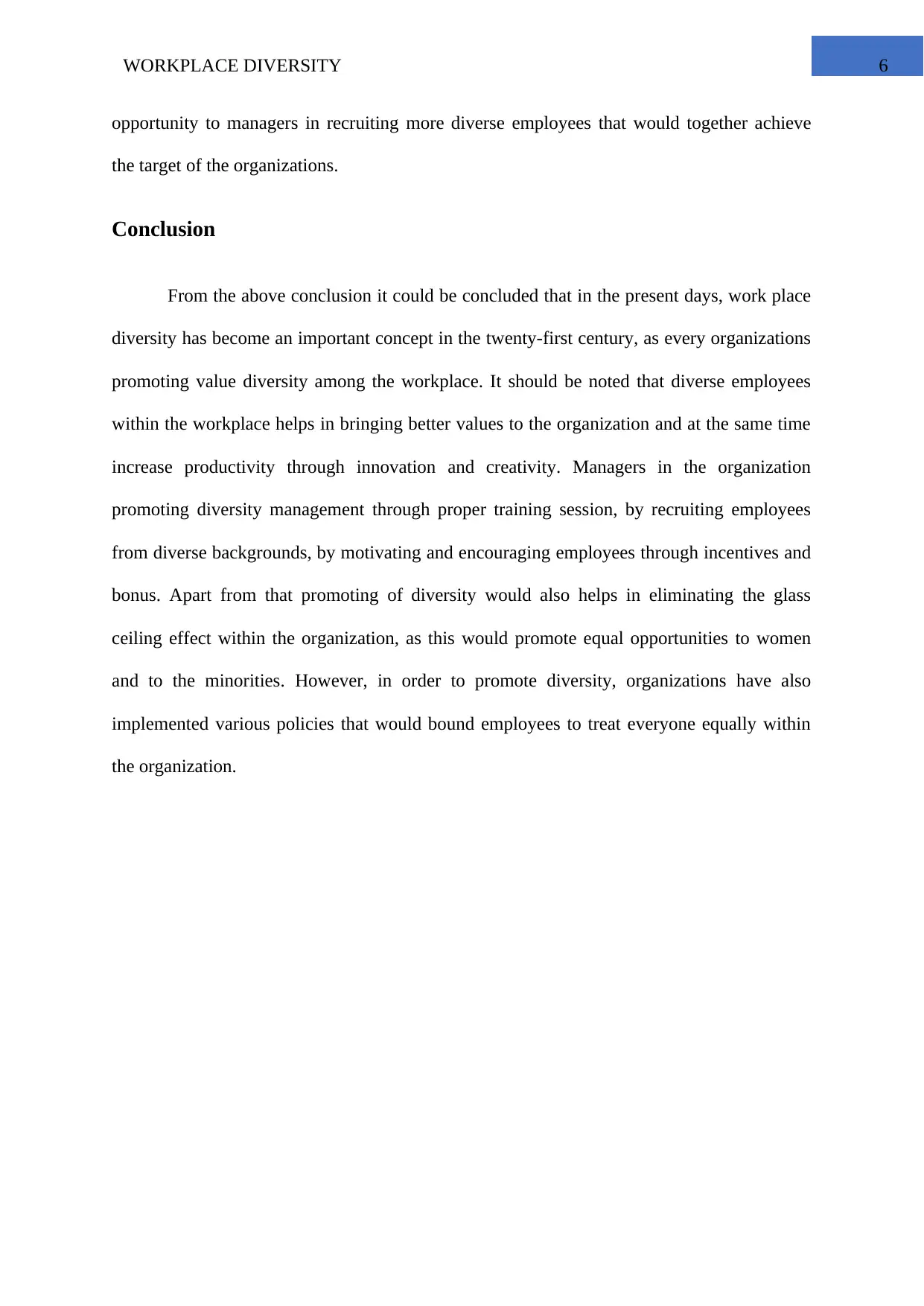
6WORKPLACE DIVERSITY
opportunity to managers in recruiting more diverse employees that would together achieve
the target of the organizations.
Conclusion
From the above conclusion it could be concluded that in the present days, work place
diversity has become an important concept in the twenty-first century, as every organizations
promoting value diversity among the workplace. It should be noted that diverse employees
within the workplace helps in bringing better values to the organization and at the same time
increase productivity through innovation and creativity. Managers in the organization
promoting diversity management through proper training session, by recruiting employees
from diverse backgrounds, by motivating and encouraging employees through incentives and
bonus. Apart from that promoting of diversity would also helps in eliminating the glass
ceiling effect within the organization, as this would promote equal opportunities to women
and to the minorities. However, in order to promote diversity, organizations have also
implemented various policies that would bound employees to treat everyone equally within
the organization.
opportunity to managers in recruiting more diverse employees that would together achieve
the target of the organizations.
Conclusion
From the above conclusion it could be concluded that in the present days, work place
diversity has become an important concept in the twenty-first century, as every organizations
promoting value diversity among the workplace. It should be noted that diverse employees
within the workplace helps in bringing better values to the organization and at the same time
increase productivity through innovation and creativity. Managers in the organization
promoting diversity management through proper training session, by recruiting employees
from diverse backgrounds, by motivating and encouraging employees through incentives and
bonus. Apart from that promoting of diversity would also helps in eliminating the glass
ceiling effect within the organization, as this would promote equal opportunities to women
and to the minorities. However, in order to promote diversity, organizations have also
implemented various policies that would bound employees to treat everyone equally within
the organization.
Paraphrase This Document
Need a fresh take? Get an instant paraphrase of this document with our AI Paraphraser
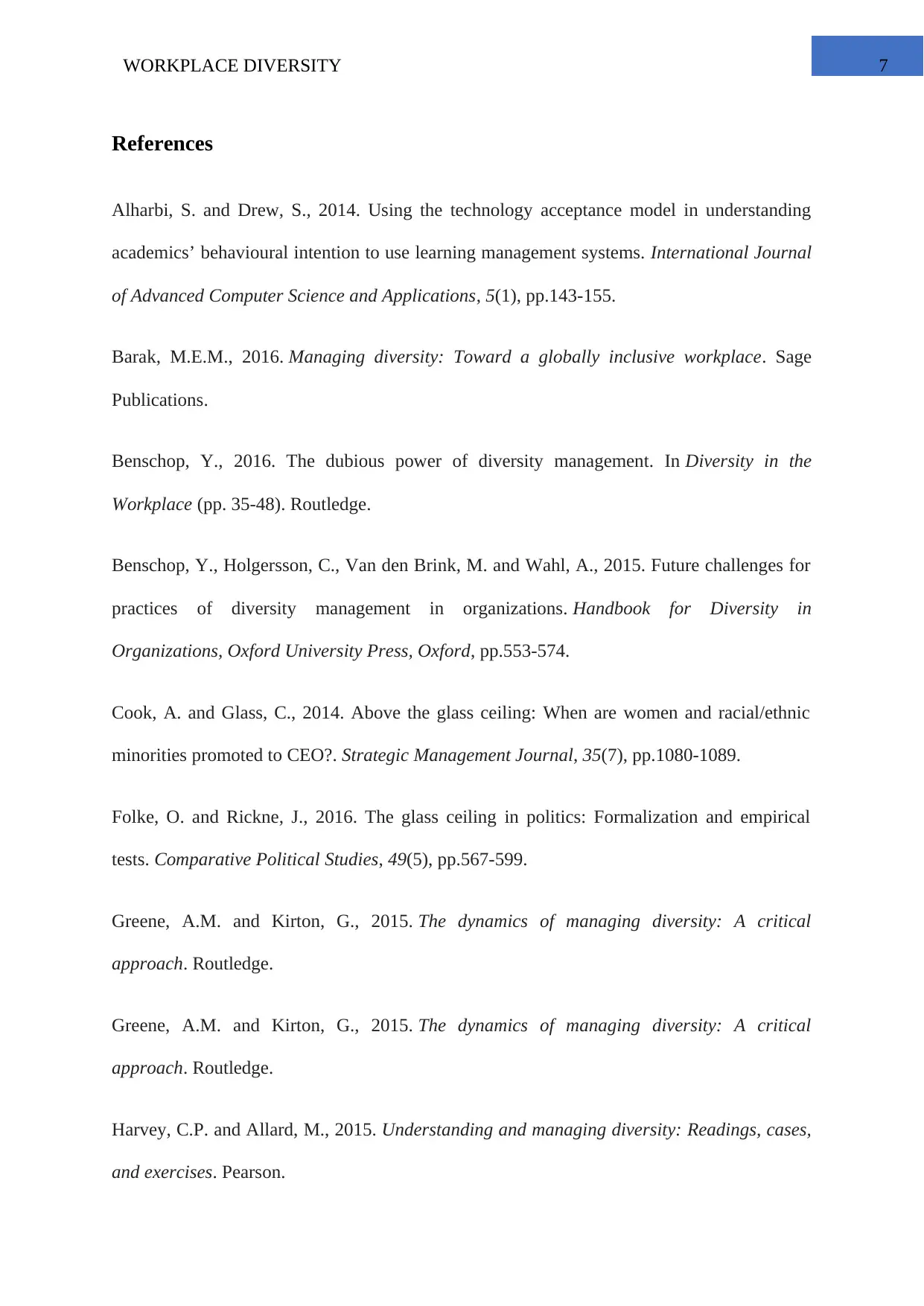
7WORKPLACE DIVERSITY
References
Alharbi, S. and Drew, S., 2014. Using the technology acceptance model in understanding
academics’ behavioural intention to use learning management systems. International Journal
of Advanced Computer Science and Applications, 5(1), pp.143-155.
Barak, M.E.M., 2016. Managing diversity: Toward a globally inclusive workplace. Sage
Publications.
Benschop, Y., 2016. The dubious power of diversity management. In Diversity in the
Workplace (pp. 35-48). Routledge.
Benschop, Y., Holgersson, C., Van den Brink, M. and Wahl, A., 2015. Future challenges for
practices of diversity management in organizations. Handbook for Diversity in
Organizations, Oxford University Press, Oxford, pp.553-574.
Cook, A. and Glass, C., 2014. Above the glass ceiling: When are women and racial/ethnic
minorities promoted to CEO?. Strategic Management Journal, 35(7), pp.1080-1089.
Folke, O. and Rickne, J., 2016. The glass ceiling in politics: Formalization and empirical
tests. Comparative Political Studies, 49(5), pp.567-599.
Greene, A.M. and Kirton, G., 2015. The dynamics of managing diversity: A critical
approach. Routledge.
Greene, A.M. and Kirton, G., 2015. The dynamics of managing diversity: A critical
approach. Routledge.
Harvey, C.P. and Allard, M., 2015. Understanding and managing diversity: Readings, cases,
and exercises. Pearson.
References
Alharbi, S. and Drew, S., 2014. Using the technology acceptance model in understanding
academics’ behavioural intention to use learning management systems. International Journal
of Advanced Computer Science and Applications, 5(1), pp.143-155.
Barak, M.E.M., 2016. Managing diversity: Toward a globally inclusive workplace. Sage
Publications.
Benschop, Y., 2016. The dubious power of diversity management. In Diversity in the
Workplace (pp. 35-48). Routledge.
Benschop, Y., Holgersson, C., Van den Brink, M. and Wahl, A., 2015. Future challenges for
practices of diversity management in organizations. Handbook for Diversity in
Organizations, Oxford University Press, Oxford, pp.553-574.
Cook, A. and Glass, C., 2014. Above the glass ceiling: When are women and racial/ethnic
minorities promoted to CEO?. Strategic Management Journal, 35(7), pp.1080-1089.
Folke, O. and Rickne, J., 2016. The glass ceiling in politics: Formalization and empirical
tests. Comparative Political Studies, 49(5), pp.567-599.
Greene, A.M. and Kirton, G., 2015. The dynamics of managing diversity: A critical
approach. Routledge.
Greene, A.M. and Kirton, G., 2015. The dynamics of managing diversity: A critical
approach. Routledge.
Harvey, C.P. and Allard, M., 2015. Understanding and managing diversity: Readings, cases,
and exercises. Pearson.
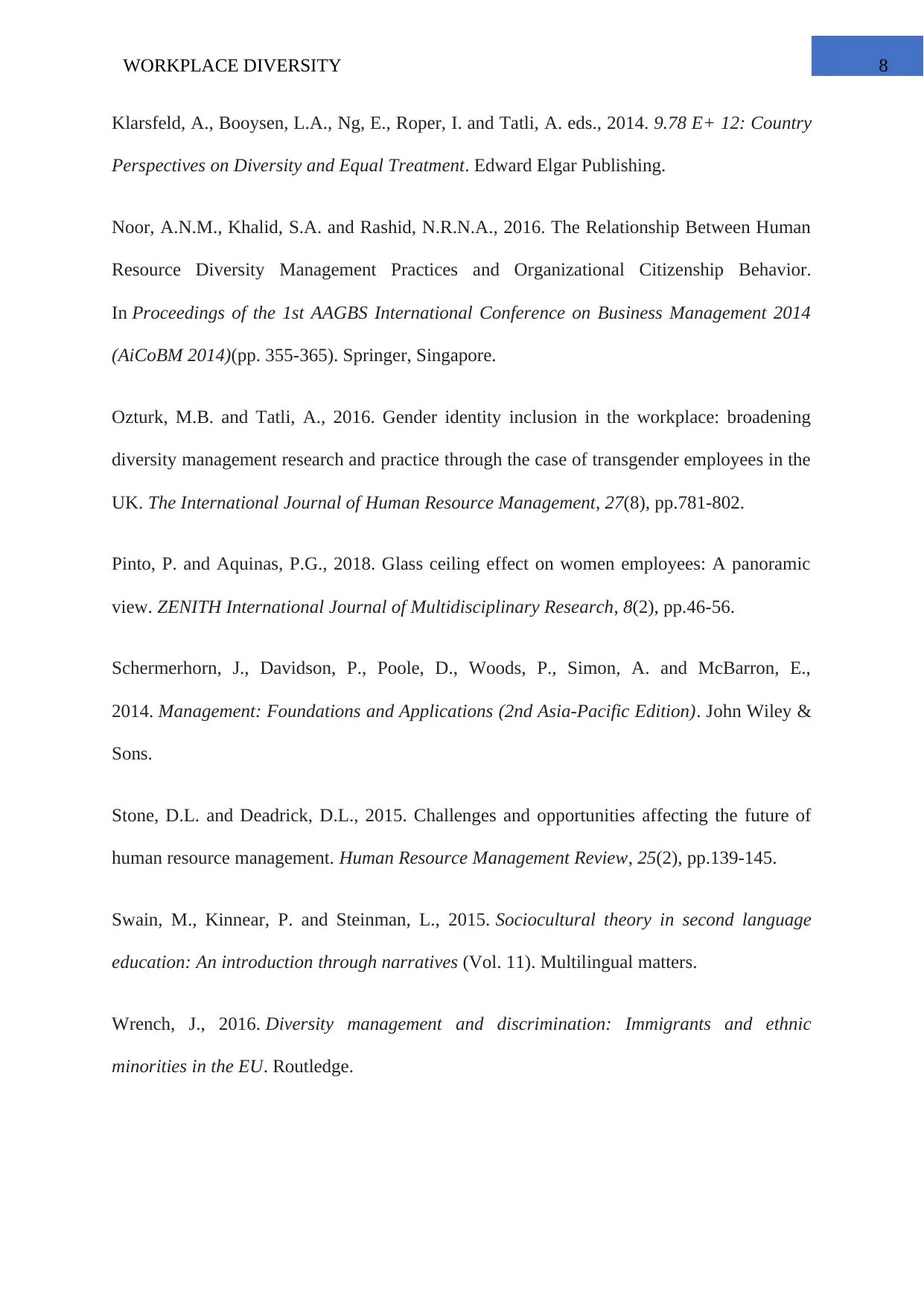
8WORKPLACE DIVERSITY
Klarsfeld, A., Booysen, L.A., Ng, E., Roper, I. and Tatli, A. eds., 2014. 9.78 E+ 12: Country
Perspectives on Diversity and Equal Treatment. Edward Elgar Publishing.
Noor, A.N.M., Khalid, S.A. and Rashid, N.R.N.A., 2016. The Relationship Between Human
Resource Diversity Management Practices and Organizational Citizenship Behavior.
In Proceedings of the 1st AAGBS International Conference on Business Management 2014
(AiCoBM 2014)(pp. 355-365). Springer, Singapore.
Ozturk, M.B. and Tatli, A., 2016. Gender identity inclusion in the workplace: broadening
diversity management research and practice through the case of transgender employees in the
UK. The International Journal of Human Resource Management, 27(8), pp.781-802.
Pinto, P. and Aquinas, P.G., 2018. Glass ceiling effect on women employees: A panoramic
view. ZENITH International Journal of Multidisciplinary Research, 8(2), pp.46-56.
Schermerhorn, J., Davidson, P., Poole, D., Woods, P., Simon, A. and McBarron, E.,
2014. Management: Foundations and Applications (2nd Asia-Pacific Edition). John Wiley &
Sons.
Stone, D.L. and Deadrick, D.L., 2015. Challenges and opportunities affecting the future of
human resource management. Human Resource Management Review, 25(2), pp.139-145.
Swain, M., Kinnear, P. and Steinman, L., 2015. Sociocultural theory in second language
education: An introduction through narratives (Vol. 11). Multilingual matters.
Wrench, J., 2016. Diversity management and discrimination: Immigrants and ethnic
minorities in the EU. Routledge.
Klarsfeld, A., Booysen, L.A., Ng, E., Roper, I. and Tatli, A. eds., 2014. 9.78 E+ 12: Country
Perspectives on Diversity and Equal Treatment. Edward Elgar Publishing.
Noor, A.N.M., Khalid, S.A. and Rashid, N.R.N.A., 2016. The Relationship Between Human
Resource Diversity Management Practices and Organizational Citizenship Behavior.
In Proceedings of the 1st AAGBS International Conference on Business Management 2014
(AiCoBM 2014)(pp. 355-365). Springer, Singapore.
Ozturk, M.B. and Tatli, A., 2016. Gender identity inclusion in the workplace: broadening
diversity management research and practice through the case of transgender employees in the
UK. The International Journal of Human Resource Management, 27(8), pp.781-802.
Pinto, P. and Aquinas, P.G., 2018. Glass ceiling effect on women employees: A panoramic
view. ZENITH International Journal of Multidisciplinary Research, 8(2), pp.46-56.
Schermerhorn, J., Davidson, P., Poole, D., Woods, P., Simon, A. and McBarron, E.,
2014. Management: Foundations and Applications (2nd Asia-Pacific Edition). John Wiley &
Sons.
Stone, D.L. and Deadrick, D.L., 2015. Challenges and opportunities affecting the future of
human resource management. Human Resource Management Review, 25(2), pp.139-145.
Swain, M., Kinnear, P. and Steinman, L., 2015. Sociocultural theory in second language
education: An introduction through narratives (Vol. 11). Multilingual matters.
Wrench, J., 2016. Diversity management and discrimination: Immigrants and ethnic
minorities in the EU. Routledge.
⊘ This is a preview!⊘
Do you want full access?
Subscribe today to unlock all pages.

Trusted by 1+ million students worldwide
1 out of 9
Related Documents
Your All-in-One AI-Powered Toolkit for Academic Success.
+13062052269
info@desklib.com
Available 24*7 on WhatsApp / Email
![[object Object]](/_next/static/media/star-bottom.7253800d.svg)
Unlock your academic potential
Copyright © 2020–2025 A2Z Services. All Rights Reserved. Developed and managed by ZUCOL.





